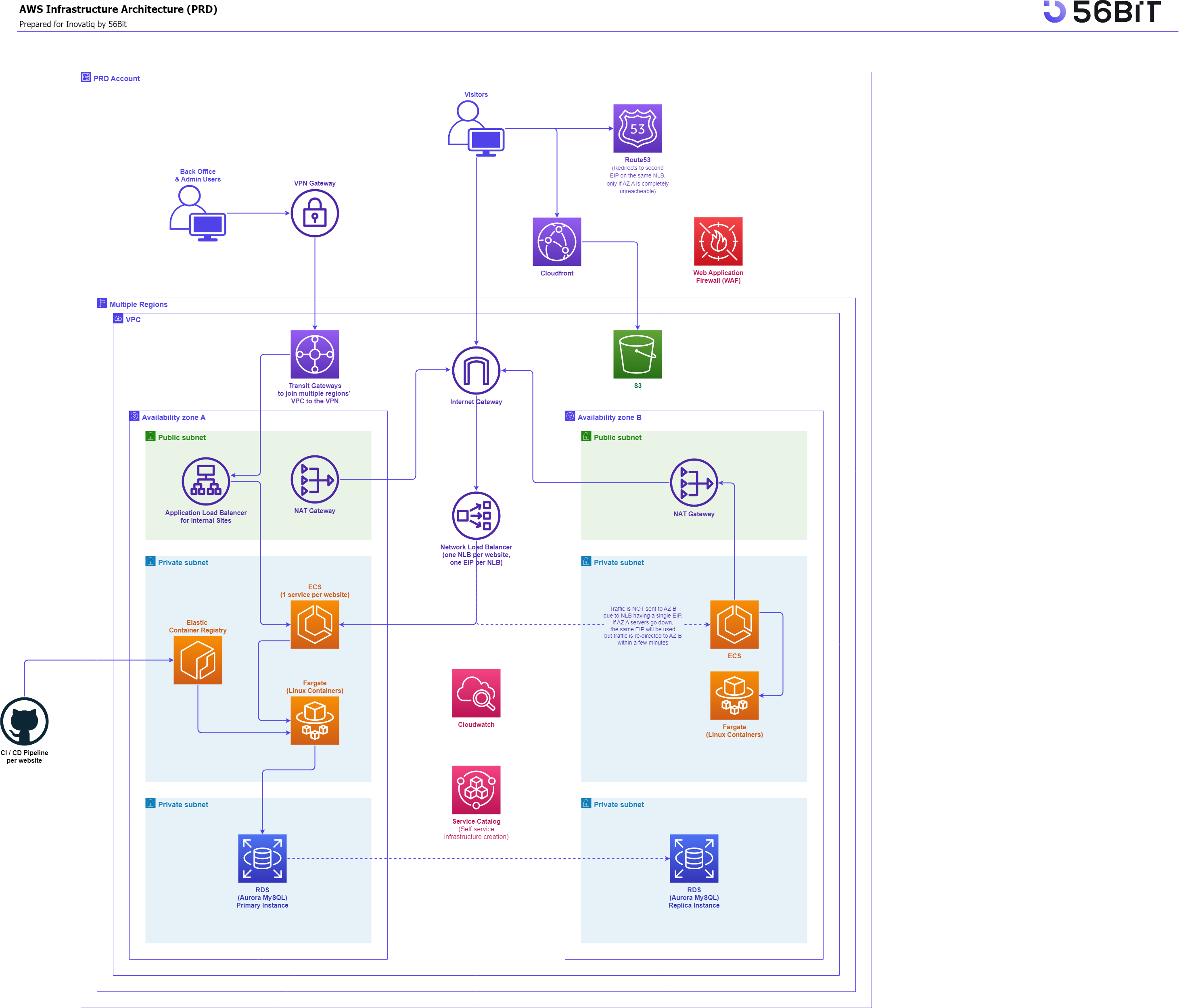Inovatiq Multi-Region WordPress.
About the customer
INOVATIQ, through their leading brand Mr Casinova, among other brands, is a lead generation performance marketing company active within the iGaming segment, targeting multiple countries on different continents. They are a high-value online lead generator operating in a complex digital iGaming world.
Customer challenge
INOVATIQ was transitioning to a new AWS hosting environment. Their existing infrastructure, primarily composed of WordPress websites running on EC2 instances, was not as efficient and modern as they desired, posing potential issues that could obstruct their business growth and customer satisfaction. They were facing challenges such as potential increased hosting costs due to inefficient resource utilization and performance issues due to infrastructure limitations.
A significant concern was their use of single instances, without any load balancing, for each website. Each website had an A record pointing to a single AWS Elastic IP address, instead of a load balancer’s highly available address. This setup introduced single points of failure that could lead to extended downtime. The lack of load balancing could have resulted in performance issues during high traffic periods and increased hosting costs due to over-provisioning of resources.
Proposed solution
In addressing INOVATIQ’s challenges, a comprehensive solution was implemented. The process began with the migration of DNS hosting to AWS Route53 for improved uptime. This was followed by implementing DNS Health Checks to allow automatic failover during full AZ failures. To ensure efficient traffic distribution, Network Load Balancers were used in place of ALBs.
The architecture was further optimized by using containers instead of EC2 instances, which allowed for multiple compute nodes per website without significant hosting costs. ECS was employed for orchestration, and a custom ECS scheduler was used to ensure multiple compute nodes per website in the primary AZ and failover capability to a secondary AZ.
AWS Fargate was utilized to launch containers on a serverless compute environment, significantly reducing hosting and management costs. All static traffic was directed through CloudFront, and caching was utilized on the containers to improve performance.
Static files were served from S3, a scalable storage service and immutable copies of critical S3 data were created and stored securely.
The S3 storage class was automatically adjusted based on data usage to optimize cost efficiency. AWS RDS was used for reliable and scalable database services. Finally, CI/CD pipelines were introduced to automate the deployment of all required WordPress files, enhancing operational efficiency and reducing the potential for human error.
Finally, Workloads were segregated at the account level for enhanced security and manageability, and AWS Control Tower was used for the creation of new AWS accounts and the enforcement of multiple guardrails.
These measures collectively transformed INOVATIQ’s infrastructure into a more resilient, efficient, and cost-effective setup, significantly mitigating the initial challenges faced by INOVATIQ and leading to improved business growth and customer satisfaction.
How AWS was used
AWS services were used to evaluate and optimize the current hosting environment, as well as design, implement and migrate to the improved AWS architecture.
AWS Services used
- Client VPN: Enables INOVATIQ personnel (Back Office & Admin users) to securely connect to the AWS environment using a VPN connection.
- AWS Route 53: Provides DNS services for INOVATIQ websites, directing clients to the appropriate entry point for the environment.
- AWS Cloudfront CDN: Caches static content (images) on edge locations closer to clients, improving performance and reducing latency.
- Amazon S3: Stores static files, such as images, for INOVATIQ websites. These images can be cached on the Cloudfront CDN before being served to clients.
- AWS Network Load Balancer (NLB): Collaborating with Amazon Elastic Container Service (ECS) and Amazon Fargate, NLB intelligently distributes incoming traffic across multiple containerized instances without the need to manage EC2 instances. This serverless architecture eliminates infrastructure provisioning and management overhead, allowing INOVATIQ’s applications to scale automatically based on demand. As traffic increases, ECS and Fargate dynamically spin up new containers and distribute traffic accordingly, ensuring high availability and scalability without the operational burden of managing EC2 instances.
- AWS Elastic Container Registry (ECR): Stores container images for INOVATIQ websites, enabling seamless deployment and scaling.
- AWS Elastic Container Service (ECS): Orchestrates the creation and management of containers running on Fargate, providing a scalable and flexible container platform.
- AWS Fargate: A serverless compute platform that runs containers without the need to manage servers or infrastructure.
- AWS Relational Database Service (RDS) for Aurora MySQL: Provides a fully managed MySQL database service for INOVATIQ websites, ensuring high availability and data integrity.
- AWS Web Application Firewall (WAF): Protect INOVATIQ’s websites and applications from a wide range of web threats and vulnerabilities using WAF’s managed rules and web access control lists (ACLs).
- AWS CloudWatch: Collects metrics and log data from the various AWS services, enabling comprehensive monitoring and analysis.
- AWS Service Catalog: Provides a self-service portal for INOVATIQ’s technical personnel to automatically create new website infrastructure, reducing reliance on external assistance.
Third Party solutions
- Word Press/PHP
- GitHub
Outcomes
- Enhanced security: INOVATIQ personnel can securely access the AWS environment through Client VPN, and all traffic is routed through Route 53 for added security.
- Improved performance: Cloudfront CDN caches static content on edge locations, reducing latency and improving page load times for INOVATIQ websites.
- Enhanced scalability: The combination of ECS and Fargate, orchestrated by NLB, enables seamless horizontal scaling of containerized applications without the need to manage EC2 instances. ECS dynamically manages the creation and deployment of new containers on Fargate, ensuring that applications can handle increased workloads effectively. NLB distributes traffic across multiple Fargate-powered containerized instances, maximizing resource utilization and optimizing performance under fluctuating demand. This serverless approach eliminates the overhead of provisioning and managing EC2 instances, streamlining application scalability and reducing operational costs.
- Streamlined deployment and management: ECS and Fargate provide a serverless container platform, simplifying container deployment and management.
- Reduced operational costs: Fargate’s serverless architecture eliminates the need to manage servers or infrastructure, reducing operational overhead and costs.
- Automated cost savings: Automatically switching off the staging environment during off-peak hours or when not in use will significantly reduce the associated hosting costs. By dynamically scaling the staging environment based on actual demand, INOVATIQ can optimize resource utilization and avoid overprovisioning. Automating the shutdown and startup of the staging environment simplifies operational processes and reduces manual intervention.
- High availability and data integrity: RDS for Aurora MySQL ensures high availability and data integrity for INOVATIQ’s databases.
- Empowered INOVATIQ personnel: The self-service portal in the Service Catalog enables INOVATIQ’s technical personnel to create new website infrastructure without requiring external assistance. This self-service capability empowers INOVATIQ to accelerate website deployment, reduce reliance on external assistance, promote consistency and compliance, empower self-service provisioning, and enhance operational efficiency.
- Automated deployments: GitHub-based CI/CD pipelines automate the build, test, and deployment of container images to ECR, ensuring consistent and reliable deployments.
- Enhanced security posture: Elevate INOVATIQ’s overall security posture by employing AWS WAF to protect its websites and applications from a wide range of web threats and vulnerabilities.
- Reduced attack surface: Minimize the attack surface of INOVATIQ’s web infrastructure by proactively blocking malicious traffic and preventing unauthorized access attempts.
Additional Considerations
- Cross-AZ load balancing: NLB is configured with a single EIP and server dynamic content to a single AZ. In case the AZ or its resources are down, the same EIP will serve traffic to the secondary AZ automatically.
- Secondary EIP failover: As a secondary safeguard, in the rare case that the EIP is completely unavailable, Route53 will be configured to switch to a secondary EIP temporarily, until the primary EIP is available again.
- Frequent backups: RDS for Aurora MySQL performs frequent automatic backups to S3, ensuring data protection in case of failures.
- Individual website scaling: Each website can be individually scaled using ECS, providing flexibility to meet specific website requirements.
- Separate databases for each website: Each website utilizes its separate database on the RDS cluster, ensuring data isolation and security.
Metrics for Success
Security
- Minimize security incidents: Strive to achieve zero security incidents for all INOVATIQ websites and applications. Leverage the Client VPN solution to restrict access to internal sites, enhancing security and reducing the risk of unauthorized access. Leverage AWS WAF to block malicious traffic and protect against common web vulnerabilities.
- Reduced unauthorized access attempts: Achieve a 50% reduction in unauthorized access attempts to all INOVATIQ websites and applications within the first six months of implementing AWS WAF.
- Enhanced web application protection: Achieve a significant reduction in the number of high-severity web application vulnerabilities identified through AWS WAF scans.
Performance
- Page load times: Achieve an average page load time of less than 3 seconds for all INOVATIQ websites.
- Server response times: Reduce server response times to an average of less than 100 milliseconds.
- Application latency: Minimize overall application latency to less than 50 milliseconds.
Cost and Infrastructure Optimization
- Overall cost reduction: Achieve an overall reduction of 15% in AWS hosting costs within the first year, encompassing both infrastructure and application expenses.
- Maximize resource utilization: Ensure efficient utilization of both infrastructure resources and application containers. Aim for an average utilization of 80% for ECS on Fargate containers and 70% for S3 storage.
- Rigorous rightsizing: Continuously monitor and optimize resource allocation to ensure that all INOVATIQ’s AWS resources are rightsized to match actual demand. Prevent overprovisioning beyond 10% to minimize unnecessary costs.
- Serverless cost savings: Utilize ECS on Fargate’s serverless architecture to eliminate the need for EC2 instance management and provisioning, achieving a minimum of 20% cost savings in EC2 expenses.
- Reduced operational overhead: Streamline infrastructure management by leveraging the serverless nature of ECS on Fargate. Significantly reduce operational overhead and manual intervention, freeing up IT resources for more strategic initiatives.
Operational Efficiency
- Minimize downtimes: Achieve no more than one downtime incident per quarter for all INOVATIQ websites and applications. Implement proactive measures to prevent downtimes and ensure seamless user experiences.
- Rapid incident resolution: Achieve a mean time to resolution (MTTR) of less than 10 minutes for incidents that cause downtime or performance issues. Employ effective incident response procedures to swiftly address any disruptions.
- Maintain a high change management success rate: Achieve and maintain a change management success rate of 99% or higher. Implement rigorous change management practices to ensure seamless and controlled deployments.
- Self-sufficient INOVATIQ personnel: Empower INOVATIQ’s technical personnel to independently manage and troubleshoot their websites and applications, reducing reliance on external support. Foster a culture of ownership and responsibility among INOVATIQ’s personnel to enhance their capacity to address issues promptly and effectively.














